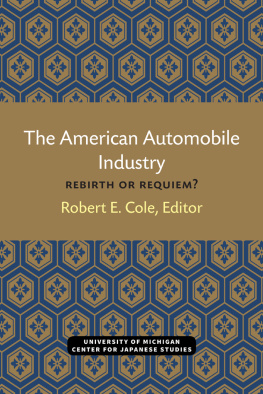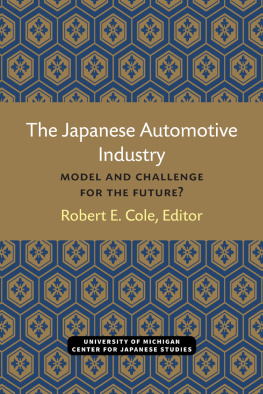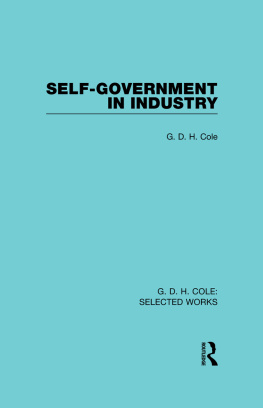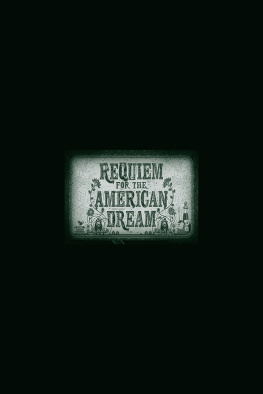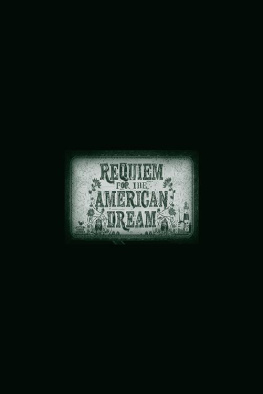Robert E. Cole - American Automobile Industry: Rebirth or Requiem?
Here you can read online Robert E. Cole - American Automobile Industry: Rebirth or Requiem? full text of the book (entire story) in english for free. Download pdf and epub, get meaning, cover and reviews about this ebook. year: 2020, publisher: University of Michigan Center for Japanese Studies, genre: Politics. Description of the work, (preface) as well as reviews are available. Best literature library LitArk.com created for fans of good reading and offers a wide selection of genres:
Romance novel
Science fiction
Adventure
Detective
Science
History
Home and family
Prose
Art
Politics
Computer
Non-fiction
Religion
Business
Children
Humor
Choose a favorite category and find really read worthwhile books. Enjoy immersion in the world of imagination, feel the emotions of the characters or learn something new for yourself, make an fascinating discovery.
- Book:American Automobile Industry: Rebirth or Requiem?
- Author:
- Publisher:University of Michigan Center for Japanese Studies
- Genre:
- Year:2020
- Rating:5 / 5
- Favourites:Add to favourites
- Your mark:
- 100
- 1
- 2
- 3
- 4
- 5
American Automobile Industry: Rebirth or Requiem?: summary, description and annotation
We offer to read an annotation, description, summary or preface (depends on what the author of the book "American Automobile Industry: Rebirth or Requiem?" wrote himself). If you haven't found the necessary information about the book — write in the comments, we will try to find it.
American Automobile Industry: Rebirth or Requiem? — read online for free the complete book (whole text) full work
Below is the text of the book, divided by pages. System saving the place of the last page read, allows you to conveniently read the book "American Automobile Industry: Rebirth or Requiem?" online for free, without having to search again every time where you left off. Put a bookmark, and you can go to the page where you finished reading at any time.
Font size:
Interval:
Bookmark:

THE UNIVERSITY OF MICHIGAN CENTER FOR JAPANESE STUDIES
MICHIGAN PAPERS IN JAPANESE STUDIES
NO. 13
MICHIGAN PAPERS IN JAPANESE STUDIES
No. 1. Political Leadership in Contemporary Japan, edited by Terry Edward MacDougall.
No. 2. Parties, Candidates and Voters in Japan: Six Quantitative Studies, edited by John Creighton Campbell.
No. 3. The Japanese Automobile Industry: Model and Challenge for the Future?, edited by Robert E. Cole.
No. 4. Survey of Japanese Collections in the United States, 19791980, by Naomi Fukuda.
No. 5. Culture and Religion in Japanese-American Relations: Essays on Uchimura Kanz, 18611930, edited by Ray A. Moore.
No. 6. Sukerokus Double Identity: The Dramatic Structure of Edo Kabuki, by Barbara E. Thornbury.
No. 7. Industry at the Crossroads, edited by Robert E. Cole.
No. 8. Treelike: The Poetry of Kinoshita Yji, translated by Robert Epp.
No. 9. The New Religions of Japan: A Bibliography of Western-Language Materials, by H. Byron Earhart.
No. 10. Automobiles and the Future: Competition, Cooperation, and Change, edited by Robert E. Cole.
No. 11. Collective Decision Making in Rural Japan, by Robert C. Marshall.
No. 12. The Sting of Death and Other Stories by Shimao Toshio, translated by Kathryn Sparling. FORTHCOMING.
No. 13. The American Automobile Industry: Rebirth or Requiem, edited by Robert E. Cole.
THE AMERICAN AUTOMOBILE INDUSTRY: REBIRTH OR REQUIEM?
Edited by
Robert E. Cole
Ann Arbor
Center for Japanese Studies
The University of Michigan
1984
Open access edition funded by the National Endowment for the Humanities/Andrew W. Mellon Foundation Humanities Open Book Program.
ISBN 0-939512-21-1
Copyright 1984
Center for Japanese Studies
The University of Michigan
108 Lane Hall
Ann Arbor, MI 48109
Library of Congress Cataloging in Publication Data
The American automobile industry.
(Michigan papers in Japanese studies; no. 13)
Proceedings of the Fourth U.S.-Japan Automotive Industry Conference held at the University of Michigan in 1984.
Includes bibliographical references.
1. Automobile industry and tradeUnited StatesCongresses. 2. Automobile industry and tradeJapanCongresses. I. Cole, Robert E. II. U.S.-Japan Automotive Industry Conference (4th: 1984: University of Michigan). III. Series.
HD9710.U52A65 1984 338.4762920973 84-17041
ISBN 0939512-21-1
Printed in the United States of America
ISBN 978-0-939512-21-8 (paper)
ISBN 978-0-472-88009-6 (ebook)
ISBN 978-0-472-90206-4 (open access)
The text of this book is licensed under a Creative Commons Attribution-NonCommercial-NoDerivatives 4.0 International License: https://creativecommons.org/licenses/by-nc-nd/4.0/
CONTENTS
Robert E. Cole
Billy E. Frye
Paul W. McCracken
Owen Bieber
Shohei Kurihara
Michael A. Driggs
Harold A. Poling
Edward J. Hayes
Gerald Greenwald
James P. Womack
John Creighton Campbell
Shafiqul Islam
Amid the gloom, indeed the despair, that prevailed among auto industry spokesmen during early 1981, we held the first U.S.-Japan Auto Conference. With all the uncertainty that accompanies a march into new territory, the conference very much resembled a call to arms as industry, union, and government officials sought to comprehend and respond to the Japanese challenge. In the subsequent two conferences in 1982 and 1983, the concerned parties displayed an impressive willingness to roll up their sleeves and get on with creating the conditions for a renewal of the industry. Yet success seemed to elude their efforts, and frustration mounted as the national recession lengthened and deepened.
It was not until our March 1984 conference that a definite change in tone became apparent. By this time, it was clear that the industry was beginning to reap the fruits of its efforts. As Paul McCracken notes in his remarks, the market for new cars was manifesting its traditional high-geared response to improved business conditions, and the voluntary trade restraints were contributing to the ability of the industry to take advantage of this renewed prosperity. In addition, those who know the industry well knew that major improvements in quality and productivity had been made, and many of the changes responsible for these improvements seemed unlikely to be reversed.
All this was much on the minds of speakers and participants during our March conference. As I write this preface in early September, relatively little has occurred to diminish this return to prosperity. Two of our speakers, Mr. Bieber and Mr. Greenwald, cautioned against overreacting to this marked improvement in the industrys performance and reminded the audience of the permanent loss of jobs and the weakened financial conditions of the firms. But such cautions could hardly outweigh the sense of relief at the improvement in industry performance. The various speakers presented an image of people who thought that they were pretty much on the way toward addressing successfully their internal problems of productivity, quality, and marketing. All that remained was to dispose of the external factors that prevented them from competing on that well-known if elusive level playing field. As one of the speakers put it (and he might just as well have been speaking for a number of the others), two thirds of the still significant manufacturing cost difference is accounted for by the yen-dollar imbalance and the tax differential between the U.S. and Japan.
of these proceedings, James Womack is quite representative when he states that American auto industry efforts to become competitive in the world auto industry largely reflect what does or does not happen within the industry. He goes on to conclude that government policy will play, at best, a supportive role. One can make a persuasive argument, for example, that the industry indulgence in awarding high bonuses to top executives did more to harm its competitive positionby demoralizing middle management, creating an expectation of business as usual among employees and the UAW, and damaging popular support for the domestic industrythan any disadvantage created by differing tax systems.
Before speculating on the reasons for the differing interpretations of industry leaders and most outside observers, particularly academics, we need to reflect on the validity of industry claims. To facilitate this process, we have broken with our past practice and included in the proceedings a section for which we have commissioned new papers and reprinted existing papers that we judged particularly relevant and timely in light of the topics of discussion at the conference. These papers deal with the potential contribution of industrial policy, U.S.-Japanese tax structures, and the yen-dollar exchange rate. In keeping with the role of the University community in sponsoring this conference, we seek to use this section to heighten discussion and bring into play differing perspectives. I have also broken with past practice in treating this preface less as a place to provide an introduction and more as an opportunity for specific discussions that are intended to enhance more thoughtful interpretations of the subsequent materials.
The vehicle for my efforts will be to share some reflections on the typical use of the phrase level playing field. The phrase is consistent with the fondness Americans display for the use of sports rhetoric. Such metaphors have great power in American culture. The imagery of an uneven playing field conveys the sense of a fundamental lack of fairness in the rules governing international trade and in the behavior of our competitors. The game of competition is being tilted in their favor. Proponents using such terminology generally conclude with a rousing statement to the effect that if these rules were just equalized, then we would have little trouble competing!
Font size:
Interval:
Bookmark:
Similar books «American Automobile Industry: Rebirth or Requiem?»
Look at similar books to American Automobile Industry: Rebirth or Requiem?. We have selected literature similar in name and meaning in the hope of providing readers with more options to find new, interesting, not yet read works.
Discussion, reviews of the book American Automobile Industry: Rebirth or Requiem? and just readers' own opinions. Leave your comments, write what you think about the work, its meaning or the main characters. Specify what exactly you liked and what you didn't like, and why you think so.

